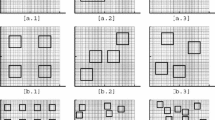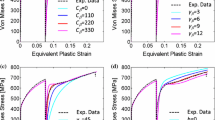Abstract
The axisymmetric cold forging is used in the automobile industry to manufacture the formed parts en masse. But, this process is often limited by the onset of surface cracking which reduces the quality of the final product. In this paper, the theoretical investigation of the initiation of the ductile fracture in axisymmetric upsetting processes is carried out using a simple method of analysis. The developed method is based on the theory of plasticity and a fracture criterion, in which the influence of the growth and coalescence of the cylindrical and spherical voids is considered. The cracking at the free surface of the cylindrical billet is modelled.
Similar content being viewed by others
References
Atkins, A.G. andY.-W. Mai: Elastic and Plastic Fracture Chichester: Ellis Horwood 1988.
Brown, L.M. andJ.D. Embury: The initiation and growth of voids at second phase particles. Proc. 3rd Int. Conf. on Strength of Metals and Alloys, Cambridge, U.K. 1973, pp. 164/69.
Chandrasekaran, N.: The phenomenon of ductile fracture. PhD-Thesis, McMaster University, Hamilton, Canada 1985.
Dodd, B. andY. Bai: Ductile Fracture and Ductility. London: Academic Press 1987.
Dung, N.L.: Identification of defect locations in uniaxial compression samples. Mech. Res. Comm. 15 (1988) pp. 123/30.
Dung, N.L.: Ein Beitrag zur Untersuchung der Rißentstehung in der Kaltmassivumformung metallischer Werkstoffe. Fortschr.-Ber. VDI Reihe 2 Nr. 175. Düsseldorf: VDI-Verlag 1989.
Dung, N.L.: On fracture criterion for metal forming processes. Proc. PLASTICITY'89, Tsu, Japan 1989, pp. 53/6.
Gurson, A.L.: Continuum theory of ductile rupture by void nucleation and growth. Part I. J. Eng. Mat. & Tech. 99 (1977) pp. 2/15.
Kao, A.S. andH.A. Kuhn: Physical modeling of ductile fracture during metalforming process. J. Eng. Mat & Tech. 112 (1990) pp. 302/8.
McClintock, F.A.: A criterion for ductile fracture by the growth of holes. J. Appl. Mech. 90 (1968) pp. 363/71.
Sowerby, R., I. O'Reilly, N. Chandrasekaran, andN.L. Dung: Materials testing for cold forging. J. Eng. Mat. & Tech. 106 (1984) pp. 101/6.
Author information
Authors and Affiliations
Additional information
Dedicated to Professor Theordor Lehmann, Bochum
Rights and permissions
About this article
Cite this article
Dung, N.L. Plasticity theory of ductile fracture by void growth and coalescence. Forsch Ing-Wes 58, 135–140 (1992). https://doi.org/10.1007/BF02561501
Received:
Issue Date:
DOI: https://doi.org/10.1007/BF02561501




